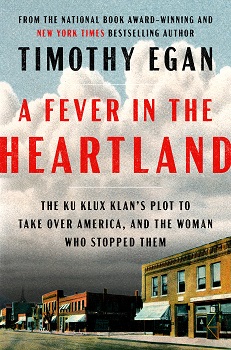A Fever in the Heartland: The Ku Klux Klan’s Plot to Take Over America, and the Woman Who Stopped Them by Timothy Egan
Seattle author Timothy Egan is adept at bringing history to life for readers, often identifying little-known people whose lives played a pivotal role in “how it all turned out.”
His recently published book, “A Fever in the Heartland: The Ku Klux Klan’s Plot to Take Over America, and the Woman Who Stopped Them,” is a riveting account of the second uprising of the Ku Klux Klan (KKK), an event that was in sharp contrast with (or possibly response to) the dramatic cultural changes of women’s empowerment, Prohibition and the Jazz Age of 1920s America.
Egan intended to write a Pacific Northwest story about the rise of the klan in Oregon. But research led him to the lesser-known story of D.C. Stephenson, a charlatan and womanizer who singlehandedly made Indiana an epicenter of klan activity and provided the momentum for klan membership growth throughout the heartland and in western states.
Grand Dragon Stephenson could be charming and knew how to manipulate an audience. Deliberately vague about his origins, Stephenson, known by his followers as simply “Steve” or fondly referred to as the “Old Man,” changed his story as it suited the moment. From a base in Kokomo, Indiana, he built the heartland klan into an empire with himself at the epicenter.
Klan targets in the 1920s were Black Americans, Jews, Catholics and immigrants. Klan members were largely white Protestants from small-town America who felt threatened by changes to American society. By the end of 1923, nationwide, the klan had nearly 3 million members; Indiana had more klansmen than any other state and the women’s klan was rapidly adding members. In Kokomo, population 30,000, half the town were klan members.
Those who put their lives and livelihoods on the line to speak out against the violence, hatred and corruption that the klan stood for quickly discovered there could be no justice when police, prosecutors, judges and community leaders were klansmen. Once a secret society whose members hid their identity under white hoods, klan membership in many areas of the heartland and western states was now a badge of honor and symbol of being a decent, God-fearing Christian.
It was the tragic death of a likable, vivacious young woman, Madge Oberholtzer, that finally revealed Stephenson as “a drunk and a fraud, a wife-beater and a sex predator, a serial liar and an unfettered braggart, a bootlegger and a blackmailer.” Oberholtzer’s family blamed Stephenson for her death and a grand jury was convened. Egan’s descriptions of the court proceedings have the feel of reading a thriller although the subject matter was horrifyingly true.
Stephenson’s eventual conviction for Oberholtzer’s death began to turn the tide against the klan. While hatred of other human beings for skin color, place of birth or religious faith was acceptable to many, the klan was now also associated with rape, murder and political corruption. “Good” people began to distance themselves from their previous klan membership and many a robe and hood were found decades later, hidden away in garages and outbuildings.
“A Fever in the Heartland” shows us another time in American history when democracy was threatened, undermined by a man who knew how to capitalize on “the renewable hate of everyday white people” who could be “induced to pay $10 for the privilege of hating their neighbors and wearing a sheet,” as Hoosier writer Meredith Nicholson summed it up at the time.
Egan suggests that Stephenson was successful in bringing about the second uprising of the klan, not because he created the perfect vehicle for hatred, but by tapping into a vein of hatred that was always there and is equally evident today. Progress and change come slowly; it was only in 2022 that a bill making lynching a federal crime was passed — 122 years and an estimated 5,000 lynchings after such legislation was first introduced.
Bellingham didn’t escape this dark time. The Exploring Systemic Racism walking tour created by Western Washington University’s Systemic Racism Curriculum Project (which can be found online) traces the route of a KKK march from Cornwall Park during the 1929 KKK convention held in Bellingham, at which time the Grand Dragon was given a key to the city by the mayor. As described in the walking tour description online, “Klan members [here in Bellingham] were involved in local government and regarded as just and heroic persons.”
I think readers will find they agree with author Erik Larson’s blurb on the back cover of “A Fever in the Heartland” calling this book “chillingly resonant with our own time.” It’s available at local bookstores, or visit wcls.org or bellinghampubliclibrary.org to request it in print, eBook or downloadable audiobook.
Lisa Gresham is collection services manager for Whatcom County Library System.
(Originally published in Cascadia Daily News, Monday, May 22, 2023.)

